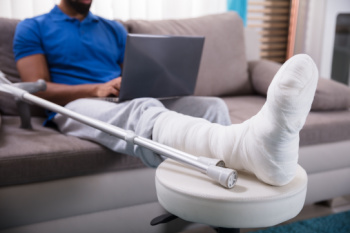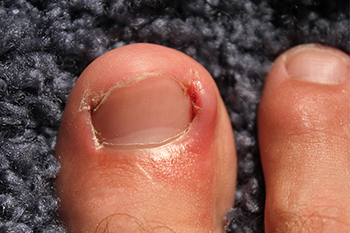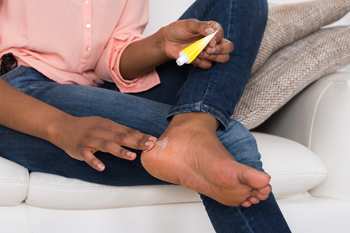August 2024
Adult Foot Fractures

Foot fractures in adults are injuries that can occur from trauma such as falls, car accidents, or even overuse. Signs and symptoms of a foot fracture include immediate pain, swelling, bruising, and difficulty bearing weight on the affected foot. In some cases, there may be visible deformity or an inability to move the toes. Diagnosis typically involves a physical examination and imaging studies like X-rays or CT scans to determine the exact location and extent of the fracture. Treatment depends on the severity of the fracture, as minor fractures may be treated with rest, compression, and elevation, along with immobilization using a cast or brace. More severe fractures may require surgery to realign and stabilize the bones with plates or screws. Healing times vary depending on the type of fracture and treatment, but generally, it takes several weeks to months. If you have sustained a foot fracture, it is suggested that you consult a podiatrist for treatment.
A broken foot requires immediate medical attention and treatment. If you need your feet checked, contact Eveleigh Williams, DPM from Sole 2 Sole, PC. Our doctor can provide the care you need to keep you pain-free and on your feet.
Broken Foot Causes, Symptoms, and Treatment
A broken foot is caused by one of the bones in the foot typically breaking when bended, crushed, or stretched beyond its natural capabilities. Usually the location of the fracture indicates how the break occurred, whether it was through an object, fall, or any other type of injury.
Common Symptoms of Broken Feet:
- Bruising
- Pain
- Redness
- Swelling
- Blue in color
- Numbness
- Cold
- Misshapen
- Cuts
- Deformities
Those that suspect they have a broken foot shoot seek urgent medical attention where a medical professional could diagnose the severity.
Treatment for broken bones varies depending on the cause, severity and location. Some will require the use of splints, casts or crutches while others could even involve surgery to repair the broken bones. Personal care includes the use of ice and keeping the foot stabilized and elevated.
If you have any questions please feel free to contact our office located in Olympia Fields, IL . We offer the newest diagnostic and treatment technologies for all your foot and ankle needs.
Are Your Shoes Right for You?

There are a lot of issues and injuries that can impact the foot, therefore it is important to make sure that you are wearing shoes that fit correctly. Shoes should be comfortable and supportive while also cushioning the foot. One way to ensure this is to purchase shoes that are specifically made for the physical activity you are doing. Another thing that can be done to ensure that shoes fit correctly is by purchasing them at the end of the day. This is because that is when your feet are the largest. The toes should be able to comfortably wiggle in the shoes, and the heel should comfortably be gripped. If you have questions about making sure you’re wearing the right shoes, it is suggested you consult with a podiatrist.
Getting the right shoe size is an important part of proper foot health. Seek the assistance of Eveleigh Williams, DPM from Sole 2 Sole, PC. Our doctor will provide the care you need to keep you pain-free and on your feet.
Getting the Right Shoe Size
There are many people who wear shoes that are the incorrect size, negatively affecting their feet and posture. Selecting the right shoes is not a difficult process, so long as you keep several things in mind when it comes to choosing the right pair.
- When visiting the shoe store, use the tools available to measure your foot.
- Be sure there is ‘wiggle room’. There should be about an inch between your toes and the tip of your shoes.
- Do not always assume you are the same size, as manufacturers run differently.
- Purchase shoes later in the day, as your feet swell as the day progresses.
- If a shoe is not comfortable, it is not suitable. Most shoes can’t be ‘broken in’, and comfort should be the ultimate goal when it comes to choosing the right pair of shoes
As our feet hold our body weight and keep us moving, it is important to treat them right. Picking the right pair of shoes can provide your feet comfort and mobility without pain.
If you have any questions, please feel free to contact our office located in Olympia Fields, IL . We offer the newest diagnostic and treatment technologies for all your foot care needs.
When to See a Podiatrist for an Ingrown Toenail
 Ingrown toenails occur when the edge of a toenail grows into the surrounding skin, causing pain, redness, swelling, and sometimes infection. This condition most commonly affects the big toe. Ingrown toenails can result from improper nail trimming, wearing tight or narrow shoes, injury to the toe, or genetic factors that cause nails to curve naturally. If you experience severe pain, significant swelling, pus, or signs of infection, or if mild treatments, such as soaking the foot and wearing comfortable shoes, do not alleviate the symptoms, it is suggested that you schedule an appointment with a podiatrist for an exam and effective treatment solutions.
Ingrown toenails occur when the edge of a toenail grows into the surrounding skin, causing pain, redness, swelling, and sometimes infection. This condition most commonly affects the big toe. Ingrown toenails can result from improper nail trimming, wearing tight or narrow shoes, injury to the toe, or genetic factors that cause nails to curve naturally. If you experience severe pain, significant swelling, pus, or signs of infection, or if mild treatments, such as soaking the foot and wearing comfortable shoes, do not alleviate the symptoms, it is suggested that you schedule an appointment with a podiatrist for an exam and effective treatment solutions.
Ingrown toenails can become painful if they are not treated properly. For more information about ingrown toenails, contact Eveleigh Williams, DPM of Sole 2 Sole, PC. Our doctor can provide the care you need to keep you pain-free and on your feet.
Ingrown Toenails
Ingrown toenails occur when a toenail grows sideways into the bed of the nail, causing pain, swelling, and possibly infection.
Causes
- Bacterial infections
- Improper nail cutting such as cutting it too short or not straight across
- Trauma to the toe, such as stubbing, which causes the nail to grow back irregularly
- Ill-fitting shoes that bunch the toes too close together
- Genetic predisposition
Prevention
Because ingrown toenails are not something found outside of shoe-wearing cultures, going barefoot as often as possible will decrease the likeliness of developing ingrown toenails. Wearing proper fitting shoes and using proper cutting techniques will also help decrease your risk of developing ingrown toenails.
Treatment
Ingrown toenails are a very treatable foot condition. In minor cases, soaking the affected area in salt or antibacterial soaps will not only help with the ingrown nail itself, but also help prevent any infections from occurring. In more severe cases, surgery is an option. In either case, speaking to your podiatrist about this condition will help you get a better understanding of specific treatment options that are right for you.
If you have any questions please feel free to contact our office located in Olympia Fields, IL . We offer the newest diagnostic and treatment technologies for all your foot and ankle needs.
Relief for Cracked Heels
 Cracked heels, also referred to as heel fissures, can be uncomfortable and unsightly. They often result from dry skin, prolonged standing, or wearing open-backed shoes. To find relief from cracked heels, begin by soaking your feet in warm, soapy water for 15 to 20 minutes to soften the skin. Gently exfoliate with a pumice stone to remove dead skin. Apply a thick, moisturizing cream or heel balm to hydrate and promote healing. For best results, do this routine before bedtime and wear cotton socks overnight to help lock in moisture. Avoid walking barefoot or wearing shoes that expose your heels. If these remedies are ineffective or if you experience severe pain, bleeding, or signs of infection, it is strongly suggested that you schedule an appointment with a podiatrist.
Cracked heels, also referred to as heel fissures, can be uncomfortable and unsightly. They often result from dry skin, prolonged standing, or wearing open-backed shoes. To find relief from cracked heels, begin by soaking your feet in warm, soapy water for 15 to 20 minutes to soften the skin. Gently exfoliate with a pumice stone to remove dead skin. Apply a thick, moisturizing cream or heel balm to hydrate and promote healing. For best results, do this routine before bedtime and wear cotton socks overnight to help lock in moisture. Avoid walking barefoot or wearing shoes that expose your heels. If these remedies are ineffective or if you experience severe pain, bleeding, or signs of infection, it is strongly suggested that you schedule an appointment with a podiatrist.
Cracked heels are unsightly and can cause further damage to your shoes and feet. If you have any concerns, contact Eveleigh Williams, DPM from Sole 2 Sole, PC. Our doctor can provide the care you need to keep you pain-free and on your feet.
Cracked Heels
Cracked heels appear unappealing and can make it harder for you walk around in sandals. Aside from looking unpleasant, cracked heels can also tear stockings, socks, and wear out your shoes. There are several methods to help restore a cracked heel and prevent further damage.
How Do You Get Them?
Dry skin is the number one culprit in creating cracked heels. Many athletes, walkers, joggers, and even swimmers suffer from cracked heels. Age and skin oil production play a role to getting cracked heels as well.
Promote Healing
Over the counter medicines can help, especially for those that need instant relief or who suffer from chronic dry feet.
Wear Socks – Wearing socks with medicated creams helps lock in moisture.
Moisturizers – Applying both day and night will help alleviate dryness which causes cracking.
Pumice Stones – These exfoliate and remove dead skin, which allows for smoother moisturizer application and better absorption into the skin.
Change in Diet
Eating healthy with a well-balanced diet will give the skin a fresh and radiant look. Your body responds to the kinds of food you ingest. Omega-3 fatty acids and zinc supplements can also revitalize skin tissue.
Most importantly, seek professional help if unsure how to proceed in treating cracked heels. A podiatrist will help you with any questions or information needed.
If you have any questions, please feel free to contact our office located in Olympia Fields, IL . We offer the newest diagnostic and treatment technologies for all your foot care needs.









